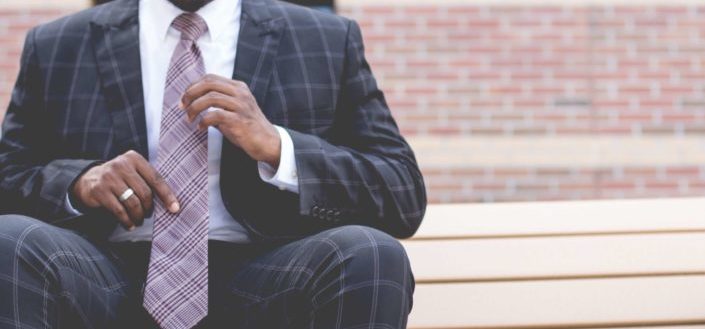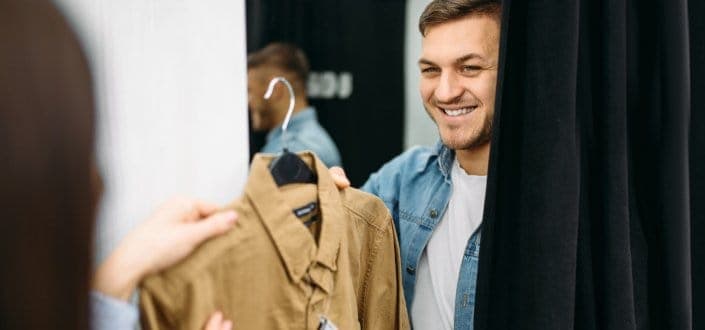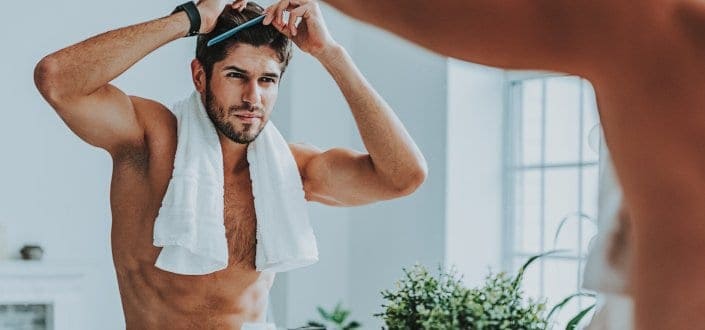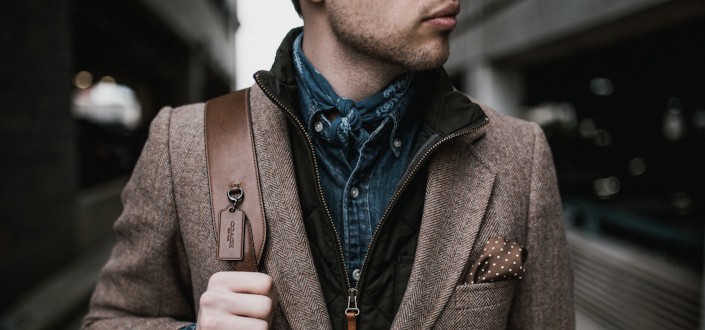
via: Bigstockphotos / Friends Stock
In this Dress For Success studies, we collected statistics from dozens of studies and surveys to come up with proven reasons you need to dress well.
Personally and professionally, there are dozens of reasons to dress well.
You'll be amazed at how important your clothing is to prospective employers... and prospective dates. Armed with this information, we created a list of style tips and rules for men that can help you look great in any situation.
The way you dress sends messages about who you are before anything you say or do, meaning your style is the most important tool you have in forming the first impression. Whether your goal is impressing an interviewer or arousing interest in a date, the way you dress matters... and understanding the unwritten rules of style could be key to dressing for success.
So if your wardrobe consists of hand-me-downs and clearance rack finds, it might be time to see all the benefits that come with putting effort into your style and learn about the reasons you should dress well.
Contents
Dress For Success Studies

via: Pexels / nappy
For many men, work is a place where we don't think about our attire. Other than making sure we follow our company's guidelines, we don't put much effort into our dress.
As the statistics in this section show, your career might be in a much better place if you did. Check out what employers and interviewers had to say about how their employees dress, and how your dress can impact some pretty big decisions.
Chances On Getting Hired
- Attractive people are 72.32% more likely to be called back for a second interview. (Statistic Brain, 2016)
- Attractive people earn an average 10% higher salary. (Statistic Brain, 2016)
- For 95% of employers surveyed, personal appearance is a contributing factor when determining whether an applicant is suitable for the job. (Forbes, 2015)
- From over 2099 hiring managers and human resource professionals surveyed, 23% of the employers recommended job seekers to wear something blue for the job interview and 15% recommended black, while 25% said orange is the worst color and is associated as being unprofessional. (Career Builder, 2013)
- 27.5% said good grooming and style of clothes show a candidate's interest in the position.
- Of 10,525 people surveyed, 76.4% believe that employers decide on whether to hire a candidate based on his appearance. (Bayt, 2013)
- 82% of employees believe they should 'dress to impress'. (Advisory, Conciliation and Arbitration Service, 2012)
- Applicants with a polished, professional appearance receive 20% higher starting salary replies. (Fox News, 2011)
- Of 1085 men and women surveyed, 75% of people believe well dressed men are more successful. (Well Dressed Men Survey, 2011)
- 55% said a man's clothing is a measurement of his level of success.
- Of over 924 men and women surveyed, 64% believe that attractive people have an easier time looking for a job.
- Respondents rated being attractive as a 63% advantage of getting the job and a 58% advantage on getting promoted. (Newsweek, 2010)
Men Who Dress Well Earn More
- Very attractive people earn 22% more than their average looking peers. (Research in Social Stratification and Mobility, 2016)
- Attractive employees earn an average of roughly 5% more while unattractive employees earn can earn almost 9% less than average. (Forbes, 2013)
- A person can earn 5% more just by wearing professional attire. (Men's Health, 2012)
- There’s about a 10 to 15% difference in earnings between the most and least attractive employees in a group. (Cornell University, 2011)
- Attractive men earn 10% more on salary compared to their less appealing colleagues. (Beauty and the Labor Market, 1993)
Getting Promoted
- Putting in the effort to dress 25% better helps you stand out in the work place. (Forbes, 2016)
- 93% of executives said that an employee’s style of clothes influences his chances of getting promoted. (Washington Post, 2015)
- 72% of hiring managers said that wearing professional attire can somewhat affect an employee's chances of getting promoted. (Office Team, 2013)
- Attractive political candidates receive 20% more votes than unattractive candidates. (Business Insider, 2013)
- Of 10,525 people surveyed, 83.4 % believe that a person's appearance is linked to his success. (Bayt, 2013)
- 78.6% said well groomed professionals have better career growth compared to average looking professionals. (Bayt, 2013)
- 41% of employers said they often promote people who dress better. (Career Builder, 2009)
- 55% of workers in the financial sector say employees who dress well are more likely to be promoted than others.
- 51% of sales representatives believe that dressing well can be a factor in earning promotions.
- 33% of manufacturing employers and 37% of IT employers say that professional attire is a contributing factor in deciding whether or not an employee gets promoted.
How Your Clothes Impact First Impressions
- According to a 2010 survey, 35% of respondents said their appearance is linked to their identity. (Allure, 2016)
- 33% said they wanted to look trustworthy, 27% wanted to look cool, 20% wanted to wanted to be seen as sophisticated or business-like, while 20% were unsure.
- Of 15 men surveyed, 67% said their clothes represent their identity, 20% said clothes somewhat represented their identity, 7% said their choice of clothes didn't represent their identity, and another 7% said they didn't care. (Fashion and Textiles, 2015)
- Of 1000 men surveyed, 60% of men who tuck in their shirts were happier in their jobs, 22% were more optimistic, 19% had higher income, and 8% dated more often. (Men's Journal, 2015)
- Of more than a 1,000 men surveyed, 66% said wearing a suit makes them feel confident, 62% said it makes them feel successful, 43% said more intelligent, 58% feel more attractive, and 34% feel sexier. (Men's Wearhouse, 2013)
- Of 10,525 people who responded to polling, 75.8% enjoy dressing up for work and taking care of their appearance. (Bayt, 2013)
- In a survey of 10,000 men and women from 12 countries, 70% of male participants maintained their appearance to be happy with themselves. (Synovate, 2008)
- Of 2497 men and women surveyed, 64% said they first notice a person's attractiveness. (Allure, 2016)
- 55% of a person's initial opinion about a person is based on the other's appearance. (Reuters, 2014)
- Of more than 1,000 men surveyed, 92% said wearing a suit makes a good first impression in professional situations while 86% said suits make a good first impression in social events. (Men's Wearhouse, 2013)
- 24% of survey respondents said clothes are the basis of their first impressions. (Pop Sugar, 2007)
- Of 4,600 people surveyed, 56% admitted that they judge a person based on what they wear. (Salary, 2011)
- 93% of a person's impression is based on how the other looks and sounds. (Lifehack)
- Of 2497 men and women surveyed, 64% of people said strangers were much more helpful because of their appearance and 62% said their appearance has resulted in better service in stores. (Allure, 2016)
- 63% of TV viewers said they prefer male presenters wearing ties. (Telegraph, 2014)
- Of more than a 1,000 men surveyed, 48% said when wearing a suit people seem to view them positively, 42% said people take them more seriously, 32% said people are nicer, and 31% said people are more trusting. (Men's Wearhouse, 2013)
- Of 10,525 people surveyed, 63.5% said they feel judged based on what they look like and their clothes. (Bayt, 2013)
- 60.2% said it is very important to look well groomed, confident, fit, energetic, and happy at work. (Bayt, 2013)
- 65% of people respect colleagues in a suit. (ACAS, 2012)
Women Are Attracted to Men Who Dress Well

via: Bigstockphotos / luckybusiness
The office isn't the only place that dressing well can pay off. Our Dress For Success studies show women pay close attention to the way men dress, and choosing the right outfit can be the key to making a great first impression.
With these Dress For Success studies, you can find out how women feel about different attire and use that information to plan your outfit for the first date or a night on the town. No matter what your personal style is, you can learn how to make it work for you and use it to attract women.
11 Clothes Women Find Sexy on Guys
- In online dating, Women were 3.5 times more likely to message a guy who wears a tailored suit and 2.3 times more likely to view his dating profile. (Hive & Colony and OkCupid, 2013)
- Of 1085 men and women surveyed, 62% of women find men in a suit professional, 60% find them more handsome, 52% said they looked sophisticated, 52% said successful. (Well Dressed Men Survey, 2011)
- 78% of women believe that dressing well is the hottest thing a man can do, 85% think that a man who dresses well is sexier than a man who has a lot of money, and 42% said they looked even more mature. (Well Dressed Men Survey, 2011)
- 63% of women prefer a man in a suit to a man in a uniform.
- 80% of women are willing to end a relationship to have a better dressed partner.
- 64% of Americans surveyed believe that women are more likely to marry a man who is well dressed than someone who is not. (Well Dressed Men Survey, 2011)
- Of 10,000 men and women surveyed, 1 in 3 women said their partner's appearance is very important to them. (Synovate, 2008)
- Of more than 200 women surveyed, 60.9% want men to wear chukka boots, 15.6% think men should wear Chelsea boots, 14.6% find boat shoes attractive, and 8.5% said loafers on men are attractive. (GQ, 2016)
- In a survey of 800 women about first date attire, 56% want men to wear “something casual but chic," 27% want "casual Friday style" (khakis or dress pants, dress shirt), 7% prefer men to go casual (jeans, T-shirt, hoodie), 6% want men to wear what they wore from work (suit or blazer, minus the tie). (Men’s Health, 2015)
- Of 3,133 American online shoppers surveyed, 47% of women prefer men to wear casual, 27% said it doesn't matter what he wears, 12% prefer business casual, 12% wanted the guy to wear a suit, and only 3% want men to wear something sporty, professional, or sexy. (PriceGrabber, 2013)
- From 387 women surveyed, 19.6% of women are very attracted to men wearing a suit on the first date. (Bows-N-Ties, 2013)
1 on Underwear
- Of 200 women surveyed, 64.5% prefer boxer briefs on a man, 19.5% prefer boxers on a man, 11.5% like trunks best, and only 5% find briefs attractive. (GQ, 2016)
2 on Pants
- Of 800 women surveyed about their preferences for men's pants, 54% prefer faded vintage style jeans, 85% want flat front pants, 34% want dark, clean denim jeans, 5% want tight, George Michael-style jeans, 4% want baggy, hip-hop-style pants, and 3% want men in ripped, rock 'n' roll style pants. (Men’s Health, 2015)
- 80.6% of women prefer Levi’s on a man, 6.5% prefer chinos, 9.7% prefer suit pants, and 3.2% said they prefer men to wear board shorts. (Esquire, 2006)
2 on Shirts
- Of 1000 people surveyed, 32% of women like suspenders and 68% like plaid shirts on men. (Ebay Deals, 2014)
- 42% said the plain white tee is their favorite on a guy, 41.9% prefer a dress shirt with French cuffs, 12.9% want men wearing a short sleeved polo, and only 3.2 % want their man in a revealing tank top. (Esquire, 2006)
1 on Suits
- 51.6% of women said their favorite type of suit jacket for men is the three button, 32.3% prefer the two button jacket, 9.7% prefer the double-breasted, while 3.2% said the Sailor's suit. (Esquire, 2006)
4 on Shoes
- Of 800 women surveyed on what shoes men should wear more often, 26% said leather loafers, 15% said wingtip dress shoes, 14% said trainers, 13% said running shoes, 9% said leather sandals, 8% said rubber flip flops, and only 7% said cowboy boots. (Men’s Health, 2015)
- 35.5% of women believe men look best in sneakers, 6.5% said suede bucks, and 19.4% said a shiny pair of dress shoes look best. (Esquire, 2006)
- Of more than 200 women surveyed on what to wear on weekends, 46.3% said slip on sneakers, 24.8% want men to wear boat shoes, 20.1% said desert boots, and 8.9% prefer men to wear driving loafers. (GQ, 2016)
- From more than 200 women surveyed, 40.7% said wearing cap toe dress shoes makes the best impression at the office, 29.4% said plain toe dress shoes, 22% prefer wing tip shoes, and only 7.9% believe men should wear monk straps to make a best impression at the office. (GQ, 2016)
Men on Buying Clothes

via: Depositphotos / Nomadsoul1
Want to know how your shopping behavior compares to other men?
Keep up with current trends and habits with these stats about men's shopping behavior. Whether it makes you recognize your shoe addiction or reveals how much more every other dude is shopping, this information can help guide your purchasing decisions.
13 Spending Habits of Men
- Men spend an average of $35 per month on clothing. (Statistic Brain, 2017)
- In 2015, 77% of American men purchased casual clothes, 73% bought jeans, 43% bought suits, and 40% purchased sport coats. (Mintel, 2016)
- 66% of men believe they are stylish while 52% choose to dress for comfort.
- In 2014, there was a 52% increase in sales of luxury timepieces, a 39% increase in footwear sales, 40% increase in small leather goods, and 24% increase in sales of luxury bags. (Euromonitor, 2015)
- 26% of men ages 25-34 buy clothes of the latest fashion. (Mintel, 2015)
- 1% of the menswear market is dedicated to the bespoke suit industry. (CNBC, 2015)
- 25% of global sales in 2013 were men's wear. (Euromonitor, 2014)
- There was a 9% increase in the overall sale of men’s accessories from 2013 to 2014. (NPD, 2014)
- Men have the 2nd highest average annual expenditures on apparel, footwear, and related products and services from 1985–2010. (Bureau of Labor Statistics, 2012)
- In 2007, there was a 17% increase in sales of men’s custom and made-to-measure suits. (Forbes, 2008)
- 63% of men own 10 pairs of shoes or less. (Time, 2006)
- On average, men own 12 pairs of shoes. (Time, 2006)
- 4% have more than 50 pairs. (Time, 2006)
6 Factors in Buying Clothes
- Of 1, 232 men surveyed, 63% go shopping to update their wardrobe. (The Boutique at Ogilvy’s Full Male Shopping Report, 2016)
- Of 2000 people surveyed, 80% of men didn't like shopping with their partners and 45% avoid shopping at all costs. (Psychology Today, 2014)
- Of 1085 men and women surveyed, 52% of men buy suits for a special occasion, 37% for weddings, 32% for interviews, 30% for a new job, 25% because they lost or gained weight,
- 36% of men enjoy dressing up and 25% love impressing others.
- 60% of men said shopping for clothes is a necessity, 50% find it fun, and 56% hate shopping for clothes.
- 48% of men experience problems while shopping compared to 53% of women.(Knowledge @Wharton, 2007)
Grooming Statistics

via: Depositphotos / iakovenko
Dressing nice is half the battle, but taking good care of your personal hygiene is the other half.
A lot of men feel lost shopping for grooming products, and feel silly spending even a few minutes in the bathroom using them. But with findings from a variety of studies, the statistics below show us how important grooming is and what kinds of grooming men (and women) are into.
Use our studies to shop more boldly and feel more comfortable putting effort into your appearance. After all, it's your body... you should take some pride in it.
10 Personal Products Men Use
- Of 600 men surveyed, 89% use shower gel, 87% prefer to use hair wax or gel for hairstyling, and 68% of men prefer a razor for shaving. (Men's Health, 2016)
- Of men surveyed, 80% use grooming products. (NPD, 2015)
- 69% use hair care products, 54% are shaving products users, 49% use body skin care products, and 22% use facial skin care products .
- 19% look for specific gender hair products, 42% use facial moisturizers, and 21% use hand and nail products
- 59% of American men use personal care products for boosting their self esteem, 37% use facial cleansers, 22% use exfoliating scrubs, 17% use anti-aging products, and 12% use eye creams.
- 63% of adult males ages 18-64 wear fragrance occasionally, 23% say they use it all of the time. (NPD, 2013)
- 40% of men who wear cologne own just one bottle. (NPD, 2013)
- 72% of male fragrance wearers started using fragrance when they were 17 years old or younger. (NPD, 2013)
- Almost 40% of male teen fragrance wearers, ages 13-17, were influenced by their fathers and most chose to wear a fragrance to impress a girl. (NPD, 2013)
- Of 6,600 online consumers surveyed, more than 5% of men spend 5 minutes or less grooming, 24% spend 6-15 minutes, 35% spend 15-30 minutes, 29% of men spend 30 minutes to an hour a day, and only 5% spend an hour or more. (Euromonitor International Personal Appearance Survey, 2014)
4 Benefits of Good Grooming
- 91% of employers interviewed believe grooming and what an applicant wears shows his attitude towards the company, while 95% said personal appearance affects their opinion of the applicant's suitability for the job. (LinkedIn, 2015)
- There's a 4% increase in average earnings for minority men who allot at least 80 minutes of personal grooming everyday. (Live Science, 2011)
- Of employers surveyed, 73% said grooming has a lot of influence in hiring a candidate, 21% said grooming had only a slight influence, and only 6% said it does not affect whether they hire a person or not. (National Association of Colleges and Employers, 2006)
- Roughly 90% of the impression you make is based on your clothing, the other 10% is based on how grooming of unclothed areas (hair, skin, nails, etc.) (Dress for Success, 1986)
Impact of Clothes Studies

via: Bigstockphotos / fizkes
Your clothes impact every area of your life... whether you like it or not.
The good news is that the impact of your clothes doesn't have to be a mystery. Using these Dress For Success studies you can find out how to dress in ways that send the messages you want to the people you want to send them to.
Getting hired
- There's only a 62.92% chance an unattractive person will be contacted for a second interview. (Statistic Brain, 2016)
- Of 501 hiring managers surveyed, 75% said wearing the wrong clothes is the number one mistake millennials make. (Forbes, 2012)
- 57% of hiring managers said that qualified but unattractive candidates have a much harder time getting hired. (Newsweek, 2010)
- Of 900 UK hiring managers surveyed, 37% of hiring executives said they have decided not to hire someone based on how they dressed. (The Guardian, 2009)
- 87% of employers said job applicants wearing nontraditional attire for an interview negatively affected their decision to hire that person. (NACE, 2006)
- 69% of hiring managers surveyed said dressing inappropriately is the largest turn off about applicants. (Career Builder)
Getting Promoted
- Of 2,175 hr managers surveyed about aspects of appearance most likely to prevent them from promoting an employee, 44% said provocative clothes, 43% said wrinkly clothes and unkempt appearance, 32% said nontraditional piercings, 27% said too casual attire, 27% said visible tattoos, 25% said an unprofessional haircut, and 24% said unprofessional facial hair. (Career Builder, 2015)
- Unattractive employees miss out on up to almost 9% on salary. (Forbes, 2013)
- Men who are least attractive make 13% less salary than average. (Beauty Pays, 2011)
- 37% of men believe that there is a connection between appearance and earning potential. (Harvard Business Review, 2011)
On Relationships
- According to 71% of women, disheveled appearance in men is a turn off. (Relationship Deal-breakers: Traits People Avoid in Potential Mates, 2015)
- Of 5,481 individuals surveyed, 58% of women judge men based on their clothes. (Match, 2013)
- Of 2000 people surveyed, 28% of women admitted to rejecting a date because of what the man wore and 31% said they have demanded their man change his clothes before going out in public because they're embarrassed to be seen with them. (Ariel, 2012)
- Of 2000 women surveyed, 59% intervened with their man’s clothes because of their dry sense of style, 18% because their man’s clothes were outdated or ageing, 31% because his clothes were ill fitting and unstylish, while 19% intervened because their man’s clothes were embarrassing. (Very, 2012)
- 37% of men in a relationship don't shop for their own clothes and about 48% are clueless of their sizes.
- 26% of men only buy clothes when their existing clothes are worn out.
- Women perceive the average man as giving up on his appearance by the time they turn 37.
- 60% of women said that clothes are the top dating deal breaker, next is a man's haircut and the style of his shoes. (Medical Daily, 2012)
- Of 1085 men and women surveyed, 9% of women would not consider going on a second date with a man who doesn't dress well, 29% considered breaking up with someone with bad choice of clothes, 31% of women were embarrassed because of what their man wore, and 32% of women admitted to having thrown their man's clothes away without telling them. (Well Dressed Men Survey. 2011)
Dress Code Violations
- Of more than 300 senior managers surveyed on most common dress code violations, 47% cited wearing clothes that are too casual, 32% said showing too much skin, 6% responded having visible tattoos or piercings, 5% said ungroomed facial hair, 4% said wearing too many accessories, and 3% listed extreme hair styles. (Office Team, 2016)
- More 53% of employers have sent employees home for not following the dress code. (CNN, 2008)
3 Fashion Mistakes Men Make Statistics

via: Unsplash / Andrew Neel
If dressing well can lead to your success, it only makes sense that dressing badly would have the opposite effect.
As you can see from the info below, most of the biggest fashion mistakes men make come down to being lazy dressers. Use this last section of our Dress For Success studies as a guide for clearing out your closet, and the sections above as a list of items to fill that empty space.
- Of 1000 people surveyed about the worst men's fashion mistakes, 20% said over accessorizing, 19% said wearing shirts with childish graphics and phrases, 12% said mixing patterns that don't match, 11% said using a backpack when wearing professional attire, 10% said suits that don't fit right, 9% said wearing running shoes with jeans, and 6% said wearing ill fitting shirts. (eBay, 2015)
- Of 4512 people surveyed about the worst men's fashion faux pas, 36.8% said sock crimes like socks with sandals or wearing white socks with dress shoes, 11.6% said dress shirts with street wear prints, 15.8% said wearing tight jeans, 8.3% dressing like a pirate, 4.9% said poor dapper look, 4.9% said combining jeans and a suit jacket, 5.9% said wearing glasses to look more intelligent intelligent, 7.1% said adding a tie to casual wear, and 2.5% said wearing age inappropriate sunglasses. (Stuff, 2012)
- In a survey about the most common clothing mistakes, 32.3% of women said men wearing pants that are too short, 25.8% said wearing socks with dress shoes and a suit that's too big. (Esquire, 2006)
In Conclusion
If you've ever felt a rush of confidence when trying on a new suit or gotten up from the barbers chair feeling refreshed and renewed, you know that there are multiple reasons to dress well.
Knowing how to dress for success and groom yourself properly can make you feel more confident, competent, ambitious, and attractive... but it's not only you that feels that way. The impact your style has on your boss and your lady are two more proven reasons you need to dress well.
This Dress For Success studies is an evidence-based list of style tips and rules for men and see the impact dressing well can have on you.







